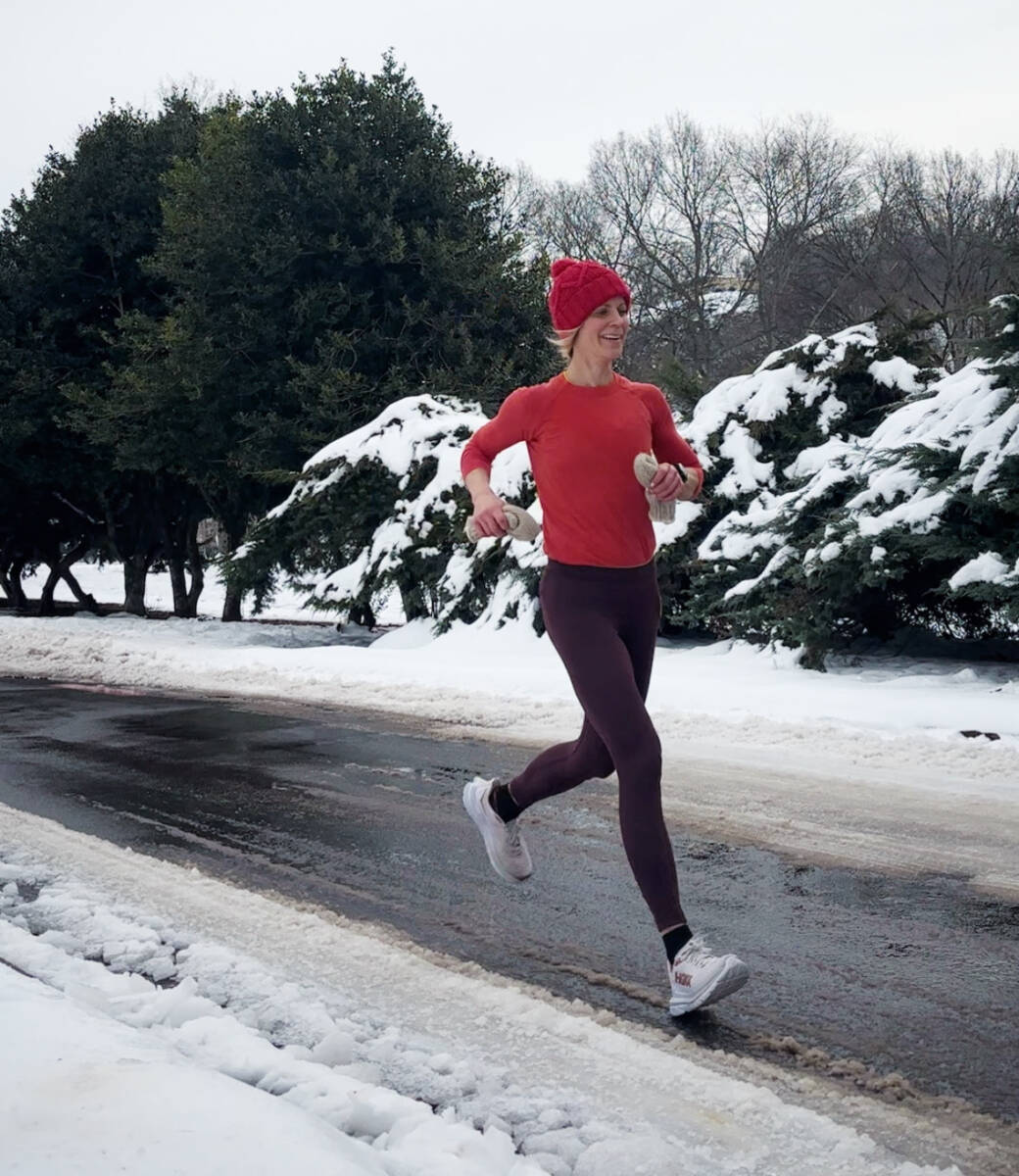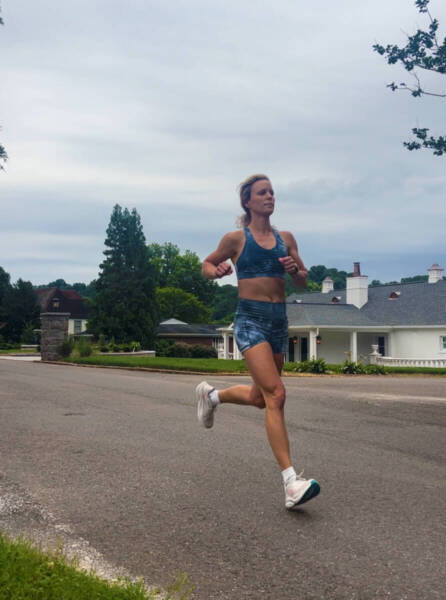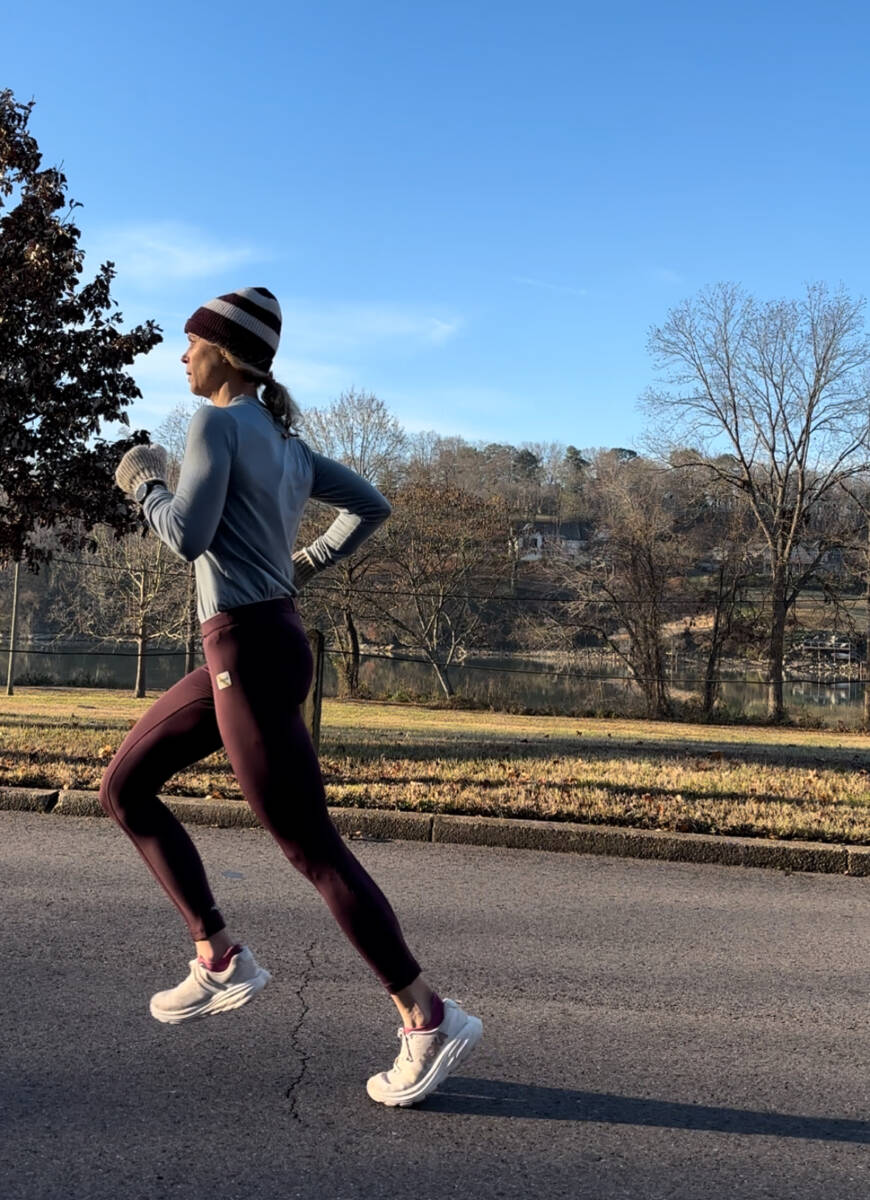How to Adapt to Racing in Bad Weather
Racing in bad weather is bad luck but can also be very likely. Runners running a race in bad weather need to adjust their mindset, focus on what they can control, and adjust their effort. Get all the racing tips below.

My two dear friends toed the line for the 2021 Indianapolis Monumental Marathon. They’ve trained so hard for this day for the last eight months in hopes of getting an Olympic Trials Qualifying time (aka an OTQ). And now, the weather is less than ideal—rain, warm temperatures, and wind gusts up to 50 miles per hour. So how do you deal with racing in bad weather?
Now thankfully, they remained confident and calm—but I was freaking out, for them, for me…how would I deal with running my marathon in bad weather? How could I let go of the goal I trained for and held so tightly to?
Most runners are Type A. We like to control things including how many miles we run a day, how much we eat, and how much we sleep (if we can as mother runners). But unfortunately, so much is out of our control—especially on race day and in a long-distance event such as a marathon.
You could be running in bad weather. Your stomach or your muscles may start cramping. You may have to use the restroom, or your shoe comes untied.
To help you cope with such variables, I reached out to some of the best running coaches in the U.S. on how they help athletes (and themselves) deal with running a race in bad weather. Let’s go!
6 Tips for How to Run a Race in Bad Weather
1. Focus on what you can control.
Winning at running and life is about knowing what you can control and what you can’t. Don’t waste energy stressing over what you don’t have any power over like the weather. Instead, relinquish that grip and adapt.
Focus on what you can control including what you wear, how you fuel, your effort, and your attitude.
If it’s:
- Raining: you may need to add a hat or some extra body glide to your body, for example.
- Hot: you may need some more sports drinks in your fueling plan.
- Balmy: you will need to tamp down effort. And finally, if the weather isn’t ideal for setting a PR, you need to adjust your attitude. Focus on what your ultimate goal is—go out there, have fun, and make yourself proud.
Remind yourself that all your sacrifices weren’t just for this one morning. It was for everything that came along with it—the betterment of yourself, the friendships, healthy life choices, and—for mother runners—teaching your kids valuable lessons.
2. Adjust your effort.
Neely Gracey, running coach, Olympic Trials Qualifier multiple times, and former pro-runner, says adjusting effort is KEY.
Gracey is big on “doing the best you can on that day.” As a pro racer, she knows some things are out of our control that impact our performance on race day. We could be getting sick or battling an injury or running a race in bad weather. So, give it all you got on THAT day which may be more or less based on the conditions.
With that, it means adjusting your effort—not focusing on specific paces—for racing in bad weather. If you’re running against a 50 mph headwind, it’s just nuts to think you can hold your goal marathon pace. If this pace is a 6 out of 10 effort, then run at a 6 out of 10 effort regardless of what your Garmin tells you.
Do regular body scans to see how you’re feeling. If your legs are burning in the marathon and you have 16 miles to go, then you need to back off, for example.
Gracey advises to not let things you can’t control rattle you. “Stay controlled and focused on the pace that feels right. Don’t overthink times and how that may reflect fitness.”
She notes Boston 2018 and Chicago 2021 showed us that you can absolutely perform well in poor conditions, both hot and cold, as long as you run within yourself.
3. Have more than one goal.
Elisabeth Scott, running coach and host of the Running Explained podcast, has her athletes come up with a range of pace goals—think A goal, B goal, and C goal. This helps athletes adjust their race plans to meet the conditions of the day including illness, injury, and running in bad weather.
The range is from conservative to aggressive. I love this approach because most of us just want to pick the aggressive pace plan because that’s what’s going to give us that PR.
Scott and Norris both advise their athletes to start a race conservatively (according to their conservative race pace even if not racing in bad weather) and then speeding up if they feel good.
“When it’s nasty, we typically go more conservative and toss out the aggressive goals entirely, focusing on PROCESS goals (fueling, hydration, holding back) to run a smart race,” she shares.
4. Compartmentalize.
Gracey also recommends compartmentalizing on race day. That means, if something bad happens, you deal with it and move on. Or you shift your focus to what is going right.
For example, if you’re running into a strong wind, don’t focus on how slow your mile split was. Put your head down, keep moving, and then move on.
If you’re soaked and cold from running in the rain, focus on how the rest of you is feeling or flip the script and be glad you’re not overheating.
Compartmentalizing is an amazing strategy to deal with hurdles that come up in running and life. Don’t continue to stress about what went wrong. Focus on what is going right and how great you’re doing in the face of challenges such as running in bad weather.
5. Change your metrics.
Claire Bartholic, running coach and host of The Planted Runner, told me in a conversation on the podcast I host, The Passionate Runner, that holding onto goals is like holding onto a bar of soap. The tighter you grip, the more likely it’s going to slip away.
I loved this analogy and it’s a beautiful reminder that our metrics of success should not be the time on the clock. It should be all the little things we did to get there—including strengthening that adversity muscle.
And what bigger test to adversity than running a race in bad weather conditions? She says:
“In marathoning and in life, you are measured by how you rise in the face of adversity. How will you rise? How will you cross the finish line with a smile on your face? Everyone running will face the same weather and everyone would finish faster in perfect conditions. How do you show that you are proud of what you have done to get here no matter what?”
Once again, we have a beautiful reminder that running is about SO MUCH MORE than the time on the clock. Don’t rob yourself of all the gifts it’s given you by only focusing on that metric. That’s not what it is about!
Zoom out and remember the big picture—for you, your life, your health, and your family—and that you and all the other runners are in this together. You’re all doing this hard thing, racing in bad weather, and using this energy to power your through and make yourself proud!
6. Don’t forget to smile.
I know it sounds cheesy but science backs this up—smiling makes the effort feel less hard and boosts your mood. So, when you feel yourself spiraling in a tornado of negativity, smile. Say something friendly to a fellow racer. Say thanks to those cheering you on, or just think of something funny.
Smiling serves as a reminder that we choose to race in bad weather or good. We do this for fun—because we love it.
No matter the race, we are going to feel discomfort. We are going to feel pain. Embrace it. We don’t grow in our comfort zone. That happens when things get hard and we push our limits beyond what we thought possible.
How to run a race in bad weather:
Below are quick practical tips for how to run a race in bad weather.
Racing in the Rain
If you are running in the rain:
- Put on a trash bag at the start
- Wear moisture-wicking fabric
- Lube up with body glide everywhere
- Ditch A goal race pace if it is pouring
- Pack dry clothes for when you finish victoriously
Get more tips for racing and running in the rain.
Racing in the Cold
If you are running a race in the cold:
- Bring old sweats you can wear at the start and shed
- Remember your body will heat up 15 degrees once you start moving
- Keep your hands and head covered
- Don’t forget to hydrate even if it’s cold
Get more tips for running in cold weather
Racing in Wind
Here’s how to run against the wind:
- Shorten your stride, lean into the wind, and put your head down
- Wear tight-fitting clothes
- If you can, tuck behind someone else aka draft
- Keep up the hydration!
- Put body glide on all exposed skin and chapstick on your lips
Racing in Snow
Here’s how to run in the snow:
- Wear shoes with good traction or spikes
- Shorten your stride and adjust your pace
- Avoid cotton and wear moisture-wicking clothes
- Keep your head and hands covered.
- Keep up that hydration!
Get more tips for running in the snow!
Racing in Hot Weather
Here’s how to run in heat:
- Prehydrate a ton with water, sports drinks, and electrolytes
- Put ice packs on your back before you race
- Put ice in your sports bra or hat
- Adjust your pace for the heat and humidity
- Be extra mindful of your hydration
Get more tips for running in hot weather!
If you need guidance with running and racing in bad weather, check out my run coaching services.
Have you run a race in bad weather?






